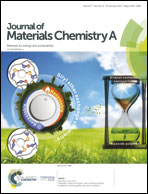A novel P3-type Na2/3Mg1/3Mn2/3O2 as high capacity sodium-ion cathode using reversible oxygen redox†
Abstract
There is great interest in the discovery of Li/Na-ion cathode materials with capacity exceeding the limitation of conventional intercalation-based oxide cathodes. One plausible but challenging path is to reversibly use the charge compensation of both lattice oxygen redox and transition metal (TM) redox. Here, we report that lattice oxygen redox alone contributes over 190 mA h g−1 charge capacity (cut-off at 4.65 V vs. Na+/Na) for the newly synthesized P3-type Na2/3Mg1/3Mn(IV)2/3O2. Similar amounts of discharge capacity are reversibly achieved. The discharge capacity exceeds 220 mA h g−1 when Mn3+/Mn4+ redox is partially used in addition to the oxygen redox reaction. This represents one of the highest energy density sodium-ion cathodes with superior low-cost. Our results reveal that cations with strong ionic bonding nature with oxygen (such as Mg2+) are very effective in inducing the reversible oxygen redox reaction. We also identified the origin of voltage hysteresis to be a P3-to-O3 phase transition in concomitance with Mg2+ migration, suggesting further structure design that reduces the structure transition induced cation migration is critical for increasing the energy efficiency of the oxygen redox reactions.



 Please wait while we load your content...
Please wait while we load your content...
